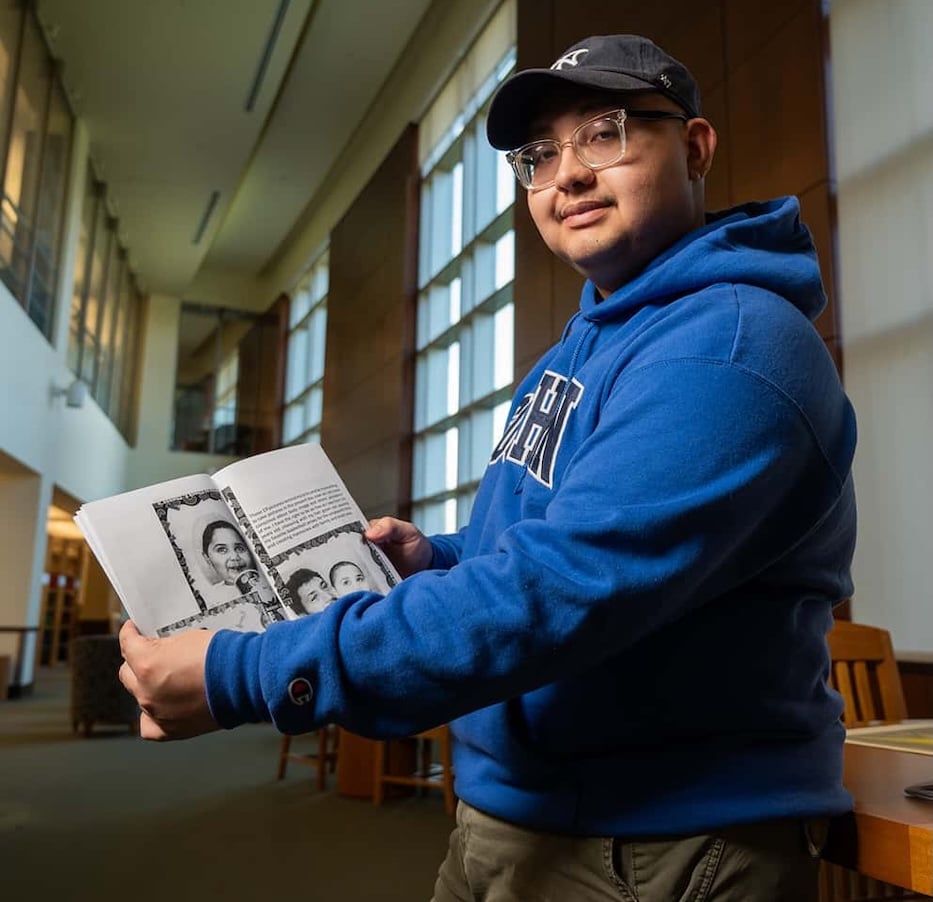
Ramirez: Tapping into the radical potential of zines. Photo contributed by Ramirez.
Inside the Hilton C. Buley Library, two tables full of craft supplies waited eagerly for a flurry of student hands, and the poetry that would push them into motion. Beside a rainbow-patterned assortment of markers, sheets of construction paper and stacks of old magazines beckoned, all asking to be snipped, reconfigured, and given new life.
That was the idea behind “Poetry in Print: Zine workshop,” held on a recent Tuesday afternoon at Southern Connecticut State University (SCSU). Sponsored by the Library of the Americas: Latino Poetry, The Latin American and Caribbean Studies program, the Art & Design Department, the Office of Diversity, Equity & Inclusion; and the American Institute of Graphic Arts, it showcased the work and mentorship of Daniel “silencio” Ramirez, a current senior at SCSU and founder of El Rincón de Papel.
El Rincón is a community resource supporting Black, Indigenous and People of Color (BIPOC) creatives working with and in paper-based formats. Like the nascent arts collective Fair Side, it is an artistic venture meant to return power and agency to creators of color who have always been working, but have long been pushed to the artistic margins.
“Paper has been used as a way to combat institutions and oppressions,” Ramirez said, describing the power that zines can have for a community. In New Haven, where they have had something of a renaissance in recent years, that’s especially true.
He explained that having an easy, accessible art medium can provide a sense of solidarity and become a platform where people come together to have a voice. As an early member of Fair Side and longtime maker in Fair Haven, he knows that firsthand: he fell in love with art during his time at New Haven Academy, and has brought that love with him to SCSU. He’s used zines—small magazines that are both art objects and documents of a specific moment, inherently ephemeral in their nature—to express some of that.
As Ramirez dove into a presentation, he looked to sources like the Queer Zine Archive Project or QZAP, a Milwaukee-based initiative that preserves queer zines and zine culture as time rolls inevitably forward. Like some of the zines that have popped up across New Haven, QZAP recognizes the power of zines as a form of storytelling, documentation, and alternative media, in the same way beloved alt-weeklies were a fixture of the late 20th century and early 2000s.
Ramirez leaned on QZAP’s definition: that a zine is “a self-published, small circulation, non-commercial booklet or magazine, usually produced by one person or a few individuals.” Many things—including low cost and the relative ease of reproduction— have made it a near-perfect medium for marginalized groups, used to uplift voices and create connection.
Ramirez moved forward to a section on the historical background of zines, including a timeline of their use for underground subcultures for decades. These include, for instance, “The Comet,” a science fiction fanzine that ran in the 1930s. Or, Ramirez said, consider zines made during the Riot Grrrl feminist movement of the 90s, all the way up until now.
Zines are still very much alive, he added—and there are many artists for whom they are an ideal medium. Today, they can be found through zine meetups, such as the New Haven Zine Scene, where a person can trade zines, meet other zine makers, and make their own.
Under the all-caps headline, “Zines Are Radical,” Ramirez then moved on to the impact zines can have in a community, both among artists and in a wider social context.
“Zines, as much as they can be a personal expression, can always be used to disseminate information during social movements,” Ramirez said, inviting participants to get a hands-on look at finished zines displayed on a back table. They included, for instance, Connectic*nt, the brainchild of Zoe Jensen, Iyanna Crockett, and Mariana Pelaez, Unmagnolia, and Against The World Plantation among others.
The presentation was meant to prepare attendees to become "zinesters" themselves. In real time, Ramirez also provided an opportunity for attendees to experience zines as the interactive medium they are. Unfolding different pieces and types of paper— cardstock, construction, printer— he showed how each had its own personality. Then he handed out a template with guided lines and page numbers. He taught attendees how to fold their own one-page zine.
For the rest of the time, participants were able to delve into the world of zine making, cutting out images from magazines that interested them, writing a poem, or drawing an original image, all were able to create their own mode of storytelling.
Glue sticks were passed back and forth in tandem with scissors and colored pencils. Encouraging words of praise were traded for the innovative ideas of the person sitting next to them.
Attendees were able to leave the workshop with the principles of zine making—that there are no rules, andthey can be made by anyone from any on-hand materials. In turn, they got a reminder: even the smallest of art actions can provide a voice and sense of community for groups that have been marginalized.
Follow silencio's artwork here.